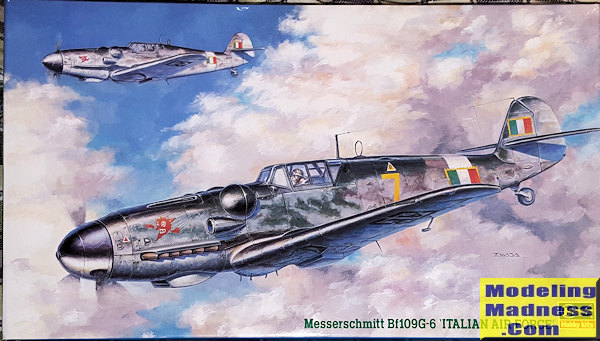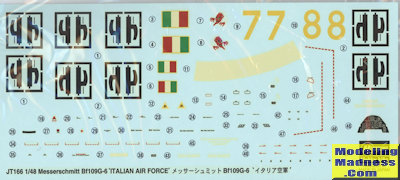
|
KIT # |
09266 |
|
PRICE: |
$10.00 from a show vendor |
|
DECALS: |
Two aircraft |
|
REVIEWER: |
|
|
NOTES: |
1998 limited edition |

|
HISTORY |
Rather than concentrate on the history of the 109 (which many readers probably have memorized by now), I'll just say a few words about 1/48 Bf-109G kits. Hard though it is to believe, there were decades when modelers had NO 1/48 109G !!
It is true. We had several 109Es (Aurora and Monogram), and later an F (Airfix), but the G models and later were sadly missing from the shelves. 1/72 didn't have it too bad as there was a selection of various 109s and the full family of them when Heller came on board with its group in the 1970s.
However, 1/48 modelers had to suffer in silence until Otaki produced a 109G-6 sometime in the early 1970s. It was a pretty good representation of the 109G and modelers were happy to at least have something. As often is the case with these early models, it had some shape problems. About the same time, Fujimi produced a 'multi-purpose' 109 kit that was allegedly able to do all the versions from G-2 to K-4. Well, sort of.
In reality, it also cut corners as there is no way to really do multiple versions in a single kit. As we know now, if nothing else, there needs to be a new cowl for the later versions. However, it did offer a tall wooden tail as an option as well as a bunch of spare bits. We were happy.
Around 1978 or so, Revell AG released their 109G-10. This was the first really accurate 109 yet done and a later version as well. It is not a bad kit at all, and one that holds up well even today. It must do well for R-M as it has been pretty well available under one name or another since it came out. Even better, it could be built as an honest, to goodness K model with a bit of scratch building. Basically that meant outer gear doors and a taller tail. We didn't worry about such things as the different rudders and such as anal had not yet reached the heights that it has today!
Moving ahead to the mid/late 1980s. Fujimi comes on line with a series of very accurate 109s. Finally we could do all sorts of different variants right from the box. The major versions done were the G-6, G-14, G-14/AS, G-10 and K-4. No need to scratch build parts and an oodle of spares with each kit. Problem was that it was imported by MRC, who has always tacked on a very high surcharge to anything it imports, so these kits were at least $30 and eventually rose to $40 each. Many of them languished on the shelves unsold as modelers of the time couldn't justify that kind of price for a 1/48 109. Those of us who did buy them, did so when they were deeply discounted.
Just a few years after that, Hasegawa finally realized that Luftwaffe kits were a cash cow and has been milking it ever since. They have produced a staggering number of kits of the 109, starting with the F. Typical of the 'multi-use' nature of model kits nowadays, there are many common sprues for several of these kits. All the 109s have exactly the same wing, landing gear and interior sprues (C,D and F). From there, the other bits like wheels, fuselage, canopy, tail planes and such are added depending on the version being kitted. I'd be remiss to not mention the Hobbycraft kits. They are not quite up to the same standards, but then they are about half the cost. Hobbycraft does variants from G-2 to K and they look very good when done.
Since then, ICM and recently Zvezda and Eduard have produced very nicely done kits of the round wing 109s and while the Zvezda kit is fiddly to the max, it has a ton of detail and the even newer Eduard offering is the current darling of the 109 crowd (assuming you don't get the initial release which was off scale).
If you check Tony Hodun's magnificent work on cataloguing the Hasegawa kits, you can see what has been done. Is Hasegawa finished with 109s? I seriously doubt it. These kits are excellent sellers and the company has realized that there is a market for the 109 in 1/32 as well.
|
THE KIT |
You have options in regards to the upper cowl, windscreen, and the left cannon
bulge depending on the plane you are doing. There are also different antennas to
use and one of the variants requires the under wing 20mm cannon pods.
The kit offers a passable cockpit, the proper wheels and as it is provided in
the box, can be built into a very nice model. There are a ton of aftermarket
options out there if you are really into adding 'stuff' to your models.

 Decals are provided for two
aircraft in the standard RLM 74/75/76 camouflage scheme as shown on the box art.
The only difference between the two options are the fuselage number. In reality
this is an RSI aircraft. The ANR was basically fascist Italians fighing on the
side of the Germans. They had very little impact on the air war over Italy and
were not all that successful. Decals are the old style where the whites are
actually off-white.
Decals are provided for two
aircraft in the standard RLM 74/75/76 camouflage scheme as shown on the box art.
The only difference between the two options are the fuselage number. In reality
this is an RSI aircraft. The ANR was basically fascist Italians fighing on the
side of the Germans. They had very little impact on the air war over Italy and
were not all that successful. Decals are the old style where the whites are
actually off-white.
|
CONCLUSIONS |
Despite not being the latest and greatest, Hasegawa 109s have a rather loyal following. They are not fiddly builds, and adorn the shelves of thousands of us. I know I have a goodly stash of these and plan on building quite a few more as time goes on. If you like 109s and haven't built one of these Hasegawa kits, you need to track one down and give it a go.
If you would like your product reviewed fairly and fairly quickly, please contact the editor or see other details in the Note to Contributors.